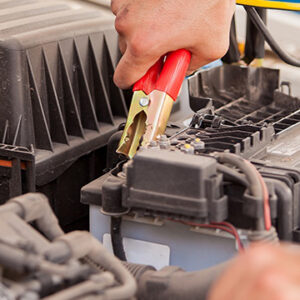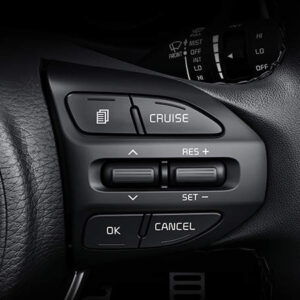When should you replace tires? New tires with sufficient tread give your car maximum traction for accelerating and braking, as well as keeping a grip around curves on the road. However, the tread wears down every time you drive — even with proper maintenance — and tire replacement is necessary for safe driving.
When Should You Replace Tires?
The best time to replace tires is before a worn or damaged tire causes you to hydroplane, skid into an accident, or have a blowout on a busy highway. Inspect your tires monthly and plan to visit your local auto dealership service department or tire retailer before a severe mishap.

Tires give clues that the end of their useful life is approaching. Some evidence may indicate safety problems requiring immediate attention. Drivers should also watch for telltale signs of potential issues from wear and aging.
Excessive Tread Wear
Properly maintained tires for the average driver can last for tens of thousands of miles. While drivers can expect the loss of tread, premature or irregular tread wear can weaken a tire and become a safety hazard. Unusual or significant tread loss may be a reason to replace a tire. Improper inflation can cause irregular tread wear, but it might be from another problem with the automobile.
- Alignment. Noticeable inner edge wear or outer edge wear may indicate the wheels are not aligned correctly.
- Overinflation. Excessive center tread wear can be a sign the tires are overinflated.
- Underinflation. Underinflated tires can cause the tread edges to wear more than the center.
Check For Tread Depth
The best way to know if it’s time to buy new tires for your vehicle is to have them inspected by a professional, but there are ways to check them yourself. To meet legal safety standards in the U.S., a tire’s tread needs to be at least 2/32” deep.
If the tires do not meet the 2/32” standard or are approaching not meeting it, you should replace your tires. When replacing tires, it’s important to select the right tire size for your vehicle.
Tires should also be free of sidewall damage and irregular wear for optimal performance and safety. It’s also a good idea to learn what types of damage can be repaired vs. replaced so that you can safely extend the life of your tires.
You can evaluate your tires on your own through a visual inspection. Start with the tread — the part of the tire that contacts the road surface. Make sure the tire tread is deep enough and worn evenly all the way around without any irregularities.
All DOT-regulated tires feature built-in treadwear indicators, commonly called “wear bars”, that will help you see when the tread is getting low.
These indicators can be found in various places throughout the tread and will be even with the tread surface when the tread is worn to two-thirty seconds (2/32) of an inch. You should also examine each tire’s sidewall to ensure there is no visible damage.
The Penny Test
You can also use the Penny Test to check your tire tread. This test can be performed in your own driveway in just a few minutes.

The idea of the penny test is to check whether you’ve hit the 2/32” threshold. Here’s how it works:
- Place a penny in the tread of your tire.
- Turn the penny so that Lincoln’s head points down into the tread.
- See if the top of Lincoln’s head “disappears.” If it does, your tread is still above 2/32” and you’re good to go. If you can see his entire head, it may be time to replace the tire because your tread is no longer deep enough.
Check all four tires, especially in areas that look the most worn. If any parts of your tire fail the penny test, it may be time to replace the tire.
Consistent wear around the whole tire is normal. Uneven tread wear could be a sign of improper inflation, wheel misalignment, or a variety of other things. If you see uneven tread wear, you should have a technician inspect your vehicle.
If your tires pass these tests, you may not need to buy new tires just yet. It’s a good idea to reassess the tread every few thousand miles, or once a month, and even more often if you’re putting a lot of wear on your vehicle or driving long distances.
Tire Damage
Regular inspection of your tires might identify areas of damage. Cuts, scrapes, cracks, and bulges in the sidewall can affect the physical integrity of the tire. If you find damage to your tire, take it to a qualified technician for an evaluation. If the damage is not too severe, you can see how much tire repair costs in your area or get an estimate.
Damage can happen from road conditions such as running over potholes and speed bumps or rubbing against curbs when parking.
Other situations can contribute to tire damages:
- Dry rot from lack of use
- Speeding
- Rapid acceleration
- Hard braking
- Hard turns
- Failure to investigate changes in performance or vibration
How to Find a Tire’s Age
While mileage is the factor commonly used to indicate tire longevity, a tire will drive safest when it gets retired by a certain age even if it did not roll up a lot of miles. Because older tires will more likely fail, manufacturers often recommend replacing tires every six to 10 years, regardless of treadwear.
You can determine the age of your tire. The DOT Tire Identification Number (TIN) is one of the many numbers on a tire sidewall. The last four digits of the TIN indicate the week and year the tire got made. A TIN that reads 0720 means the tire came out of the factory in the seventh week of 2020.
A three-digit date code indicates the manufacture date is a pre-2000 manufacture date. So, it’s best to replace the tire because of its age.
What Kind of Tires Should I Buy?
It’s best to replace your tires with the exact original equipment manufacturer (OEM) tires that your vehicle was wearing when it first rolled off the assembly line.

Automotive designers and engineers sweat the details to ensure the thousands of parts that make up your vehicle all work together to give you a safe, secure, and reliable ride. So follow the advice in your vehicle’s owner’s manual and exchange your tires with like-sized replacements.
You must consult with your dealership, tire company, or sizing expert if you decide on a different sized tire and wheel combination. Changing the size of your tires may change certain other aspects of your vehicle, such as handling, suspension, braking abilities, and more. Always consult with an expert familiar with your model and its specifications.
Tire replacement cost depends on many variables, such as the brand and where they are purchased. Even so, you can expect to pay close to $200 per tire, including installation. With the change in the retail landscape, auto dealerships are now offering tire pricing that is competitive with specialized tire retail outlets.
Tire Upkeep and Rotation
Once you have replaced your old tires with a new set, it’s time to take care of your investment. As the price of everything, including tires, continues to climb, protect them by using best practices in extending their life. Good maintenance includes rotating your tires every 5,000 miles or six months, whichever comes first.
Most cars today follow crisscross tire rotation patterns.
- Front-Wheel Drive: Move the front tires to the rear. Move the rear tires to the front, crossing the left rear to the right front and the right rear to the left front.
- Rear-Wheel Drive: Move the rear tires to the front. Move the front tires to the rear, crossing the left front to the right rear and the right front to the left rear.
- All-Wheel Drive: As with the pattern for rear-wheel drive, move the rear tires to the front. Move the front tires to the rear, crossing the left front to the right rear and the right front to the left rear.
- Four-Wheel Drive: Exchange the right front tire with the left rear, and the left front tire with the right rear tire.
- Uni-Directional: Specialized tires in which the tread only rolls in one direction, they should be exchanged from the left rear to the left front, and the right rear to the right front.
There are exceptions, of course, notably in the case of staggered tire sets, where the rear tires are of a larger size than the front tires. In that situations, follow instructions as detailed in your vehicle’s owner’s manual.
If you do the tire rotation yourself, be aware that Tire Pressure Monitoring Systems (TPMS) may not immediately recognize that tires were rotated. In those cases, reset the system by following instructions in your owner’s manual that will help ensure your tires are being cared for and inflated properly.
FAQs
How long do tires last on average?
On average, tires last about six years or between 36,000-75,000 miles. But the actual lifespan of tires varies with factors like climate, maintenance and driving habits. No matter how they look, tires should never be used longer than 10 years.
When should I really replace my tires?
You should consider replacing your tires when the tread has worn down below the recommended depth of 2/32nds of an inch or they’re over six years old. You might also need to replace your tires if you notice changes in how your tires perform. Losing traction and constantly having to air them back up are common issues with worn out tires.
Should you replace all four tires at once?
If you drive an all-wheel drive vehicle, you’ll likely need to replace all four tires at the same time to avoid affecting the vehicle’s drivetrain. In other types of vehicles, you have more options.
If you’re needing to replace a damaged tire and the other tires still have substantial tread and are in good shape, you can replace just the one tire. Talk with a tire specialist about the best way to go about replacing tires if you’re unsure.
Above is information about When should you replace tires? that we have compiled. Hopefully, through the above content, you have a more detailed understanding of What kind of tires should i buy? Thank you for reading our post.









